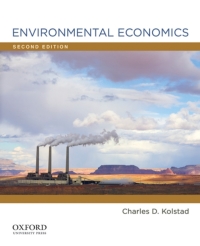Consider the problem of automobile pollution in a large city in Central Asia. There are a million
Question:
Consider the problem of automobile pollution in a large city in Central Asia. There are a million cars in the city, each emitting 10 grams of carbon monoxide (CO) per kilometer \((\mathrm{km})\) driven. On average, each car is driven \(10,000 \mathrm{~km}\) per year. The average cost to each driver is approximately 1 Ruble/ \(\mathrm{km}\) whereas the marginal cost is lower and independent of \(\mathrm{km}\) traveled, at about 0.3 Rubles \(/ \mathrm{km}\) (because of the large fixed cost of owning an automobile). A recent study of driver behavior determined that individual demand for kilometers driven was roughly linear; if a gas tax were instituted that raised the marginal cost of driving by \(0.1 \mathrm{Rubles} / \mathrm{km}\), the average car owner would reduce driving by about \(1,000 \mathrm{~km}\) per year. Each kiloton ( 1,000 tons) of CO emitted in a year raises the average concentration of CO by \(1 \mu \mathrm{g} / \mathrm{m}^{3}\). A team of economists, biologists, and physicists determined that the marginal damage per unit of ambient concentration of CO is roughly constant, \(10,000,000\) Rubles per year per \(1 \mu \mathrm{g} / \mathrm{m}^{3}\).
a. For an individual, what are the annual emissions when the "price" of emissions is zero? What about when the price rises to R10 per kg? R20 per kg? Draw an individual's supply curve for emissions - the relationship between price ( \(\mathrm{R}\) per \(\mathrm{kg}\) ) on the vertical axis and quantity of emissions \((\mathrm{kg})\) on the horizontal axis.
b. Draw the aggregate supply for emissions over all individuals, showing the price ( \(\mathrm{R}\) per \(\mathrm{kg}\) ) on the vertical axis and the quantity of emissions (kilotons-millions of \(\mathrm{kg}\) ) on the horizontal axis. In another graph, draw the equivalent curve for the supply of pollution, showing the quantity of pollution on the horizontal axis \(\left(\mu \mathrm{g} / \mathrm{m}^{3}\right)\) and the price in millions of Rubles per \(\mu \mathrm{g} / \mathrm{m}^{3}\) on the vertical axis. This is the marginal savings from polluting. Draw the marginal damage from pollution on the same graph. What is the efficient ambient concentration of CO? Call this value \(S\).
c. What are the average emissions per car associated with this efficient concentration of CO? If you could observe emissions from each automobile, what emission charge would you levy per \(\mathrm{kg}\) of emissions per car to obtain the efficient concentration?
d. You are advising the Local Environmental Protection Committee and point out that emissions from individual cars are very difficult to measure. You recommend an ambient fee to control this pollution. In other words, each driver would be assessed a charge, based on observed ambient conditions only (such a fee was described in this chapter). How much would each driver have to pay if ambient pollution levels exceeded \(S\) by \(1 \mu \mathrm{g} / \mathrm{m}^{3}\) ?
e. Discuss the answers to parts (c) and (d).
Step by Step Answer:






